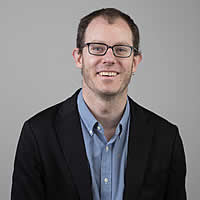Paul Benzon
 Who are you? Your name, department, what you teach, your FYE topic, etc.
Who are you? Your name, department, what you teach, your FYE topic, etc.
Greetings, Class of 2025—welcome to Skidmore College! My name is Paul Benzon, and I’m an Assistant Professor here in the English Department, and I also teach courses in the Media and Film Studies Program. My area of specialization is contemporary literature and media studies, and this fall I’ll be teaching a Scribner Seminar on “Weird Books,” where we’ll look at books not just as texts to read, but as physical objects and works of art.
Why Kendi? What makes this text so important? Why choose it as the FYE reading?
This past year I was also on the FYE Reading Committee that selected Ibram X. Kendi’s How to Be an Antiracist as this year’s first-year reading, and one of the things that I think is so important about this book is the way it takes up the question of racism and antiracism. Right at the start of the title, that How to Be an Antiracist—that embodies a kind of interdisciplinary thinking that’s a huge part of the FYE, and of what we do at Skidmore more broadly. As you go to read this book, you’ll see that Kendi is thinking about race through history, through political science, through gender studies, through Black studies, but it’s never just any one of those approaches. It’s always about how to think and act more broadly in relation to this urgent contemporary problem of racism.
So in my course in particular, we’ll use Kendi’s book as a jumping-off point for looking at a range of works that take up questions of race and racism in unconventional ways, whether that’s through typography and visual design, or the materials they’re made of, or their shape and physical form, and ultimately we’ll be thinking about what it means for a book to be antiracist not just in what it says but in how it works as a physical object.
Open the book up for students -- how should they approach it? What questions, goals, etc., should they bring to it?
And as you go to read this book over the summer, I encourage you all to think about it openly and self-reflectively: to think about where you see yourself in it and what you can learn from it to think about where and how Kendi connects race to other questions of identity, whether that be gender, or class, or educational status, or others; and to think also about what moments in this text resonate with what you’ve learned in the past about race and what seems new and different to you.
Ultimately I hope you come to campus ready to engage thoughtfully and sensitively, with this book and Kendi’s argument, with your new classmates, and with all of us here at Skidmore. So happy reading, and we look forward to seeing you in the fall!